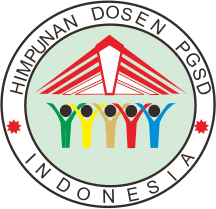Analisis keterampilan 4c (critical thinking and problem solving, communication, collaboration, creativity and innovation) dalam buku siswa kelas iv subtema aku dan cita-citaku
Abstract
Abstract. This study intends to describe the outcomes of the 4C skills analysis. (Critical Thinking and Problem Solving, Communication, Collaboration, Creativity and Innovation) Subtheme I and my values in the fourth grade student's textbook. This study utilized a qualitative descriptive approach for its design. The utilized methodology is content analysis. Document analysis is used to gather information. The test for validity employs theoretical triangulation and boosts the persistence of observations. The technique for data analysis consisted of three steps: data reduction, data display, and verification. The results indicated that communication abilities were 100 %, with the majority of Let’s Reading activities focusing on communication. 76% of students scored above average in critical thinking and problem solving, Let's Practice tasks that emphasize critical thinking and problem solving, 37% of students were found to possess collaboration abilities, and Let's Discuss activities are the most effective at encouraging students to collaborate, 16% of youngsters demonstrated creative and imaginative abilities, and Let's practice and Collaborate with Parents activities are the most influential in fostering these qualities. Based on these data, it can be stated that the subtheme's activities incorporate 4C competencies..
Kata kunci: The 4Cs, critical thinking and problem solving, communication, collaboration, creativity and innovation, Student book.Full Text:
PDFReferences
National Education Association, Preparing 21st Century Students for a Global Society. . [2] A. T. E. Faradina, A. R. As’ari, dan S. Sukoriyanto, “Analisis Potensi Penyajian Prosedur Buku New Syllabus Mathematics Jilid II Dalam Meningkatkan Kemampuan Berpikir Kritis,” J. Pendidik. Teor. Penelitian, dan Pengemb., vol. 4, no. 11, hal. 1522, 2019, doi: 10.17977/jptpp.v4i11.13026. [3] A. Widodo, D. Indraswati, dan M. Sobri, “Analisis Nilai-Nilai Kecakapan Abad 21 dalam Buku Siswa SD/MI Kelas V Sub Tema 1 Manusia dan Lingkungan,” Tarb. J. Ilm. Kependidikan, vol. 8, no. 2, hal. 125, 2019, doi: 10.18592/tarbiyah.v8i2.3231. [4] M. K. Arista Suriati, Chandra Sundaygara, “Analisis kemampuan berpikir kritis pada siswa kelas x sma islam kepanjen,” vol. 3, no. 3, hal. 176–185, 2021, [Daring]. Tersedia pada: https://doi.org/10.21067/jtst.v3i3.6053. [5] Baharuddin dan N. Wahyuni, Teori Belajar dan Pembelajaran. Yogyakarta: Ar-Ruzz Media, 2015. [6] M. Yusuf, METODE PENELITIAN Kuantitatif, Kualitatif, dan Penelitian Gabungan. 2017. [7] S. Hermawan dan Amirullah, Pendekatan Kuantitatif dan Kualitatif. Malang: Media Nusa Creative, 2016. [8] Sugiyono, Metode Penelitian Pendidikan: Pendekatan Kuantitatif, Kualitatif, R&D, 26 ed. Bandung: CV. Alfabeta, 2015. [9] D. S. Nahdi, “Jurnal cakrawala pendas,” vol. 5, no. 2, hal. 133–140, 2019. [10] H. D. Schunk, Learning Theories. Yogyakarta: Pustaka Pelajar, 2012. [11] E. Syaputra dan S. Sariyatun, “Pembelajaran Sejarah di Abad 21 (Telaah Teoritis terhadap Model dan Materi),” Yupa Hist. Stud. J., vol. 3, no. 1, hal. 18–27, 2020, doi: 10.30872/yupa.v3i1.163. [12] S. Widodo dan R. K. Wardani, “Mengajarkan Keterampilan Abad 21 4C (Communication, Collaboration, Critical Thinking And Problem Solving, Creativity And Innovation) Di Sekolah Dasar,” Model. J. Progr. Stud. PGMI, vol. 7, no. 2, hal. 185–197, 2020, doi: https://doi.org/10.36835/modeling.v7i2.665. [13] D. F. Hakim, “Meningkatkan Hasil Pembelajaran Ips Tentang Perkembangan Teknologi Komunikasi Melalui Penggunaan Pendekatan Saintifik,” PIWURUK J. Sekol. Dasar, vol. 1, no. 1, hal. 12–23, 2021, doi: 10.36423/pjsd.v1i1.639. [14] I. Y. Rizki, M. Surur, dan I. Noervadilah, “Jurnal Visipena Volume 12 , Nomor 1 , Juni 2021 PENGARUH MODEL INKUIRI TERBIMBING ( GUIDED INQUIRY ),” vol. 12, no. 1, hal. 124–138, 2021. [15] R. H. Mardhiyah, S. N. fajriyah Aldriani, F. Chitta, dan M. R. Zulfikar, “Pentingnya Keterampilan Belajar di Abad 21 sebagai Tuntutan dalam Pengembangan Sumber Daya Manusia,” Lect. J. Pendidik., vol. 12, no. 1, hal. 29–40, 2021, doi: https://doi.org/10.31849/lectura.v12i1.5813. [16] E. Inderasari, W. Oktavia, T. Agustina, dan N. Fajriyani, “HIGHER ORDER THINKING SKILL ( HOTS ) TAKSONOMI PADA ANALISIS KEBAHASAAN BUTIR SOAL BAHAN AJAR BAHASA INDONESIA TINGKAT SMA / MA,” vol. 5, hal. 110–114. [17] D. Budiastuti dan A. Bandur, Validitas dan Reabilitas Penelitian. 2018.
Refbacks
- There are currently no refbacks.



